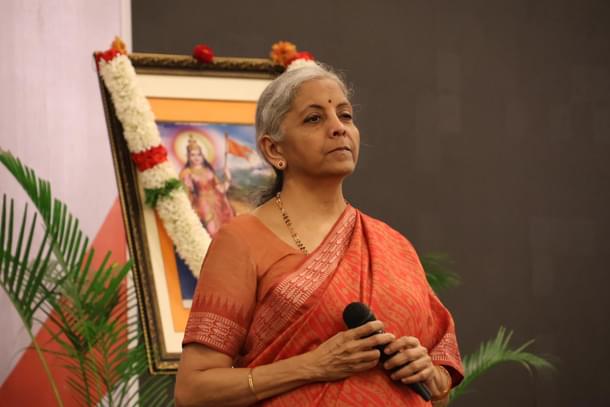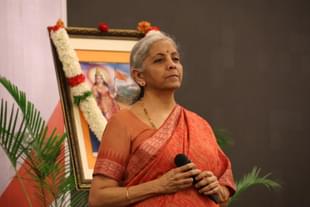Politics
'Kerala Congress Invited Adani For Vizhinjam Port, Communists Were Okay': Highlights From Nirmala Sitharaman's Response
Nishtha Anushree
Jul 30, 2024, 06:46 PM | Updated 06:46 PM IST
Save & read from anywhere!
Bookmark stories for easy access on any device or the Swarajya app.


Finance Minister Nirmala Sitharaman on Tuesday (30 July) responded to the Opposition leaders' remarks on the Budget 2024-25 in Lok Sabha. Here are key highlights from her speech:
1. Capital expenditure: Sitharaman asserted that capital expenditure has yielded results in post-Covid economic recovery. She said that of total expenditure of Rs 48.2 lakh crore, Rs 11.1 lakh crore are for capital expenditure.
"Budgeted capital expenditure is now almost 3.3 times the capital expenditure of 2019-20. If we calculate effective capital expenditure, it is Rs 15.02 lakh crore or above 18 per cent of RE of 2023-23," she added.
2. Expenditure on other sectors: "Agriculture and allied sectors in 2013-14 had just Rs 0.3 lakh crore, now it is 1.2 lakh crore. It is Rs 8,000 crore more than last year (2023-24)," the Finance Minister said.
"In education, employment and skilling, Rs 0.85 lakh crore was allocated in 2013-14, whereas today it is Rs 1.48 lakh crore, which 23 per cent (Rs 28,000 crore) more over the last year," she continued.
For women and girls, Rs 0.96 lakh crore was spent in 2013-14, it is Rs 3.27 lakh crore now, she said adding about increased expenditure on rural and urban development.
3. Fiscal deficit: Sitharaman said that the government will bring the fiscal deficit below 4.5 per cent of the Gross Domestic Product (GDP) by the year 2025-26 after an unprecedented high of 9.2 per cent in 2020-21.
4. Jammu-Kashmir: "We have provided Rs 17,000 crore in the Union Budget of Jammu and Kashmir including Rs 12,000 crore for financing cost of Jammu and Kashmir Police, so that the Union Territory can spend more on development," she said.
Sitharaman added that the unemployment rate in Jammu-Kashmir is coming down due to avenues of self-employment and the support of the government. She also stated the works done for tribal communities.
5. State distribution: The Finance Minister clarified that if a state is not named in the budget speech, that does not mean that it will not get any money and attacked the misleading campaign of the Opposition.
Sitharaman listed how more than a dozen states were not named in the Budget speeches of the UPA era and questioned, "Did the UPA not give money to them?"
Presenting random examples, she said, "Bulk Drug Parks in Himachal Pradesh got Rs 1,900 crore. PM Mitra Textile Park went to Tamil Nadu, Karnataka and Telangana. West Bengal, Jharkhand and Bihar got Railways package."
6. Kerala: "Major highway project for NH 66 in Thrissur district worth Rs 9,667 crore. Rs 1,148 crore for Mukola junction in Kerala near Tamil Nadu border," Sitharaman said responding to Kerala MPs' allegations of no funds.
7. Adani port: "We celebrated when a very big vessel reached Vizhinjam port. Nobody who speaks about A1 and A2 (Adani and Ambani), questioned Kerala Congress government when Vizhinjam was given on invitation," she said.
Sitharaman added that the Union government gave Rs 818 crore for the viability gap of the project, for which Congress invited Adani and the Communist government did not question but they lectured the BJP.
8. Agriculture: "Rs 3.24 lakh crore has been disbursed for 11 crore farmers (under PM Kisan Samman Nidhi). Institutional credit targets for agriculture have increased more than 2.5 times," she said.
"The number of accounts of small and marginal farmers availing agricultural loans with subsidy has grown from 57 per cent in 2014 to 76 per cent now," the Finance Minister stated.
9. MSP: "The Swaminathan Commission had recommended in 2006 that Minimum Support Price (MSP) should be 50 per cent more than average cost of production but was not accepted by the UPA government," she said.
Attacking the Congress corruption, she said, "CAG found gross irregularities in implementation Rs 50,000 crore farmer debt waiver scheme of 2009. 22 per cent of cases had lapses."
10. Unemployment: "In the UPA era, total employment declined between 2012-13 and 2013-14. Formal employment was badly hit. UPA era had more decline in employment than the Covid pandemic," she said.
"Labour force participation has increased. Women participation also increased. The unemployment rate declined to 3.2 per cent 2022-23," Sitharaman said praising the Narendra Modi government.
11. Inflation: "We saw a double-digit high inflation period during the UPA era. The Finance Minister used to pressurise the RBI to soften interest rates and present a rosier picture, this a former RBI governor has written in a book," she said.
"India's inflation is must lower than the global average in the post-Covid world. NDA 1 and 2 have average inflation of 5.1 per cent. BJP states cooperated by decreasing fuel prices but UPA states did not do that," she alleged.
12. SC, ST and women: "The allocations for them have gone up substantially. In 2023-24, Rs 1.59 lakh crore was for SC, this time it is Rs 1.65 lakh crore. Rs 1.19 lakh crore was for ST, it is 1.24 lakh crore now," she added.
"Rs 2.38 lakh crore was for women last year. This time it is 3.27 lakh crore," Sitharaman said questioning the Karnataka Congress government for diverting SC-ST fund to unknown expenditure.
13. Skill India mission: "In the last decade, the employability rate of Indian youth has increased sharply, rising from 34 per cent in 2014 to 51 per cent in 2024 because of upskilling and upgrading," the Finance Minister said.
"We were at 19th position in 2017 in World Skills competition. Today we are at 11th position," she added.
14. Global hunger index: Sitharaman questioned how countries like Pakistan and Sudan are ranked better than India in Global Hunger Index, despite our country distributing free ration to 80 crore people.
15. Household savings: She said that net financial savings have increased by 70 per cent. "Savings are shifting in form of physical assets rather than financial assets," Sitharaman explained.
16. Budget transparency: "The borrowings are meant for financing fiscal deficit. Borrowing has been reduced due to better fiscal management. This explains fiscal prudence of PM Modi," she said.
"This is total contrast to UPA. That time, fiscal deficits were hided through off budget borrowings and issuance of oil bonds to transfer fiscal burden to future generations," the Finance Minister alleged.
17. Minorities: Remembering late Shafiq-ur Rahman Barq, grandfather of Sambhal MP, Sitharaman said, "Minority budget has not come down. It is Rs 85 crore more than the last year."
18. West Bengal: "Its share in total industrial production of country was 24 per cent at time of independence, today it is 3.5 per cent. There is a downward trend in gross capital formation," the Finance Minister said.
19. Entrepreneurship: Sitharaman attacked the Opposition's anti-entrepreneurship narrative and called it a shame. "The conspiracy is to end India's entrepreneurship culture, even before it fully blooms," she alleged.
20. Halwa ceremony: "When the Budget used to get printed in the printing press of Minto road, the staff used to organise Halwa making there because Indian tradition is to start good work with sweets," she explained.
"Now five nights and four days, the officers stay in the cellar of North block for confidentiality of the Budget making. Before they go in, we have Halwa ceremony. This has a sense of solidarity among team members. The staff themselves make the Halwa," she added.
"When did this become a photo ceremony? In 2013-14, Halwa distribution by Finance Minister started. At that time, why Leader of Opposition (Rahul Gandhi) did not question how many SC, ST and OBC are there?" she said.
"Why did he not cancel Halwa then? Malai khaane wale were thrown out of Parliament by people. There is a conspiracy of dividing people behind this question," Sitharaman said.
She also quoted first PM Jawahar Lal Nehru's dislike of the reservations and when former PM Indira Gandhi kept Mandal Commission report in the cold storage. She said, that's why there are less OBC officers at secretary level.
"Charity begins at home. I am asking how many SC, ST and OBC are in Rajiv Gandhi foundation? There are none. Similarly, no SC is in Rajiv Gandhi Charitable Trust. First bring your house in order, then ask us," she said.
Nishtha Anushree is Senior Sub-editor at Swarajya. She tweets at @nishthaanushree.





